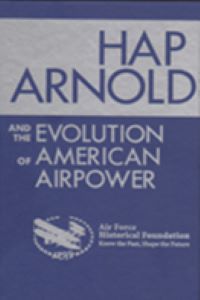- AFHF Member Authors, USAF Academy Department of History
Hap Arnold and the Evolution of American Airpower
by Dik A. Daso
Taught to fly by the Wright Brothers, appointed the first and only five-star general of the Air Force, and remembered as the man who won World War II’s air war, Henry Harley “Hap” Arnold is one of the most significant figures in American aviation history. From 1938 to 1946, as the first Commanding General of the US Army Air Forces—the largest, most powerful air armada that has ever been assembled—Arnold fought World War II not in the field but in Congress, on the Army General Staff, in factories, and in universities. His vision of airpower as more than just sophisticated aircraft not only established US air supremacy during the war but also laid the foundations for the technology, infrastructure, and philosophy of today’s air force.
In the thoroughly detailed Hap Arnold and the Evolution of American Airpower, biographer Dik Alan Daso draws on Arnold’s personal papers and declassified documents to sketch out the adventurous career, dynamic personality, and bold vision of the “father of the Air Force.” Daso traces a career centered around the airplane, the technological achievement that revolutionized twenieth-century warfare.
Describing the technology, institutions, and individuals—from the Wright Brothers to the president of Caltech—that influenced Arnold’s decisions as a general, Daso shows how the peacetime experiences of World War II’s foremost military airman shaped the evolution of American military aviation as a whole.

